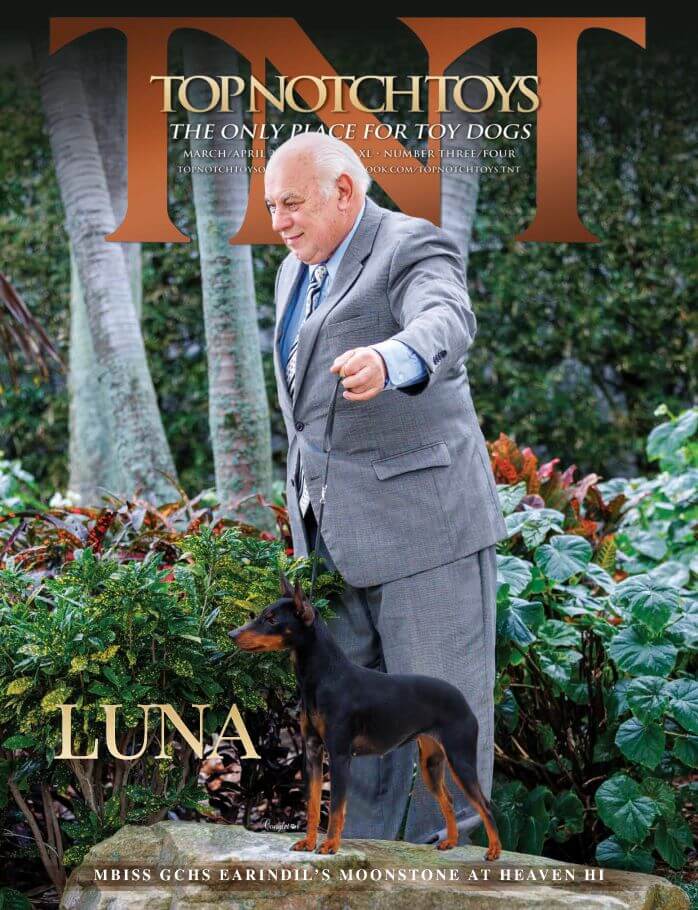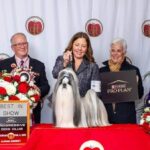Showight June 2020 Issue
- Where do you live? What is your occupation? How many years in dogs?
- Do you have any hobbies or interests apart from breeding and showing dogs?
- Everyone recognizes the Chihuahua. What don’t most people know about the breed?
- Can you talk about the Chihuahua’s “saucy” expression? His “apple dome” head? His “sickle” tail?
- What about correct proportion for the breed?
- Are there key differences between Smooth Coats and Long Coats?
- The Chihuahua is a colorful breed. Can you speak to any preferences for solid, marked or splashed coats?
- Is the typical Chihuahua a dependable show dog? An affectionate companion?
- What are the challenges of breeding and keeping the world’s smallest purebred dog? The joys?
- For a “little” bit of fun: What’s the most comical thing you’ve ever witnessed (or experienced) at a dog show?
- Is there anything else you’d like to share about the breed? Please elaborate.
Melanie Bowling
I live in Simpsonville, Kentucky. My husband, Scott, and I have been married nearly 24 years. I have a bachelor’s degree in mathematics and a master’s degree in education, but quit teaching to raise my two kids: Hailee, now 24; and Taylor, now 22. We had horribly-bred pet Chihuahuas for about ten years; all the health, genetic research led me to showing and breeding, which I’ve been doing for 8-1/2 years. (I needed a hobby when my kids started driving.) I focus on health and soundness of mind and body in addition to correct conformation. Our Chihuahuas are all house pets first, show dogs second. I’ve bred/co-bred over 20 AKC Champions, have bred several Top-20 Chihuahuas, multiple Group placers, a Best in Specialty Show winner, and a Group winner. I’m a breeder/owner-handler of my own dogs. All of my breeding dogs go through extensive health testing and have their CHIC number.
Do I have hobbies outside of dogs? No, well, my family, but my husband races cars and so we get to travel together for each of our hobbies.
What don’t most people know about the breed? They are so incredibly smart and trainable, too smart for their own good, really; smarter than many owners and that’s when they can become “monsters.” And they’re compassionate; fiercely loyal, which can be misunderstood. They really have an unwarranted, bad reputation.
Can I talk about the Chihuahua’s “saucy” expression, “apple dome” head and “sickle” tail? The “saucy” expression should convey that they are up to something, very clever. Not sweet, but also not mean or harsh. There’s nothing more Chihuahua, in my opinion, than a beautifully-shaped, apple-dome head with a saucy expression. Large, round eyes and large ears placed properly. It is the breed. The sickle tail is a critical piece of the outline. Too many Chihuahuas in the ring with pig tails or tails laying on their backs. It really ruins the outline which should be distinct from any other breed. I’m very big on a correct outline with a pretty, balanced side-gait.
What about correct proportion for the breed? Slightly longer than tall. I feel like there are many differing interpretations of “slightly.” For me, it’s no more than 10%. I’d prefer shorter-backed to longer if given the choice.
Are there key differences between Smooth Coats and Long Coats? I am partial to long coats. For me personally, they are much easier to groom! They seem to shed less. Not always true, but I do find long coats to be on the sweeter side, less stubborn than smooth coats. I guess because it’s easier to see every flaw, I’m much, much pickier on smooths. However, this makes an exceptional moving smooth coat even more eye catching to me. Smooth coat is dominant and long coat is recessive. I only breed long coat to long coat or smooth coat to long coat. That way I have either all long coat litters or at least a shot at mixed litters of both varieties.
Can I speak to any preferences for solid, marked or splashed coats? Any color is accepted in our breed. I prefer flashy, white markings on either a cream, fawn, or red coat with dark eyes and pigment. Expression is such a key component and from across a room, I feel like that’s what the eye is drawn to. I do have self-colored dogs in my breeding program; pigment isn’t everything, by any means, but it is a personal preference. Nothing is prettier than a very expressive black tri, but harder to see from a distance.
Is the typical Chihuahua a dependable show dog and affectionate companion? I would say a typical Chihuahua is probably not a dependable show dog, but a lot depends on knowing how to handle a Chihuahua. There’s a whole lot of “user error.” They are very full of themselves and self-confident, well they should be. They can easily overrun a “soft” handler. What works with one Chihuahua may not necessarily work for another. I look for a very independent, curious, self-confident puppy at a young age as my possible next show prospect. A well-bred, socialized, and properly raised Chihuahua is a wonderful companion. Those that are put in pet homes make great ambassadors for the breed, breaking the bad stereotypes.
What are the challenges of breeding and keeping the world’s smallest purebred dog? The challenges are definitely in the whelping box due to being the smallest purebred breed. Lots of sleepless nights, c-sections, hand raising of puppies, puppy losses. But that makes the successes and joys that much more rewarding!
The most comical thing I’ve ever witnessed at a dog show? I am very often so focused on my own dog in the ring that I miss most of what else is going on around me, but I will say I’ve been marked by more than one male Chihuahua in the ring claiming me as their own. That’s always funny after the fact!
Chihuahuas are the most incredible breed. Loyal, smart, sassy, opinionated, adorable, playful, animated, eternal puppies! They are very much a large, athletic dog in a tiny package and that’s a huge part of why I’ve fallen in love with them.
Steve Hayden
I have been in dogs since 1978. Kennel name is HAYBROOK. I started in Miniature Schnauzers, and then picked up Chihuahuas and Japanese Chin as a second and third breed. I have bred, exhibited, and finished all three colors of Miniature Schnauzers, Smooth Coat Chihuahuas, and Japanese Chin in all colors. Our dogs have won many Regional and National Specialties over the years as well as being nationally-ranked.
Since 1995, I have concentrated on judging. I am currently approved to judge the Toy Group, Non-Sporting Group, Terrier Group, Miscellaneous Group, Junior Showmanship, and Best in Show.
Over the years, I have judged the National Specialties for all of the breeds in which I am considered a breeder judge. I greatly appreciate the honor my fellow breeders have bestowed on me.
I have never been afraid to step up to the plate to work for canine organizations. Here is a list of just some of them: Illinois Federation of Dog Clubs, President; Illinois Capitol Kennel Club, Treasurer–past President, Vice-President, Secretary, and Board Member; Land of Lincoln Chihuahua Club, President, past Vice-President and Board Member; Japanese Chin Club of America – past President, Treasurer, Vice-President, Board Member, JEC Chairperson; American Miniature Schnauzer Club (AMSC) member since 1983; and Breed Mentor for Miniature Schnauzers, Chihuahuas, and Japanese Chin.
I live in Springfield, Illinois. I’m now retired. I was a Real Estate Broker and Pre-License Instructor for 14 years after retiring from 29 years in State Government as the State of Illinois Data
Provisioning Manager.
Do I have any hobbies or interests apart from breeding and showing dogs? Food; I love to cook comfort food and bake bread.
What don’t most people know about the breed? People think they are ankle biters—and they can be. They are extremely smart, and have their people favorites. They are sturdier than most give them credit and are good watchdogs.
Can I talk about the Chihuahua’s “saucy” expression, “apple dome” head and “sickle” tail? Well, let’s see. Saucy expression: There is a twinkle in the eye when they look at you with a hint of mischievousness. Apple dome: The best way to see this is in side profile. Picture a side profile of a red delicious apple; high forehead, definite stop. Sickle tail: The tail had a curve like a sickle and is usually carried up over the back or out to the rear as an extension of the level back.
What about correct proportion for the breed? Slightly out of square. If you start thinking the height is too short for the length of body or the length is too long or short for the height, then the dog is not “slightly out of square.”
Are there key differences between Smooth Coats and Long Coats? The only difference should be the length of coat.
Can I speak to any preferences for solid, marked or splashed coats? All colors or patterns are equal when evaluating the Chihuahua. No preference should be given or favored during evaluation. I like all.
Is the typical Chihuahua a dependable show dog and affectionate companion? Yes to both.
What are the challenges and joys of breeding and keeping the world’s smallest purebred dog? Probably the most challenging of breeding the Chihuahua is the litter size, c-section or natural birth, and survival rate. For the joys, when all come out alive, suckle, and the dam loves all of them.
The most comical thing I’ve ever witnessed at a dog show? I think the best response to this is I have fun when I judge and every show is different. There is always something that makes me laugh at every show. Exhibitors just need to loosen up a little and have fun with their dogs at the shows.
Lori Kruger
I live in Thunder Bay, Ontario, and have worked for the Ontario Government (Corrections) for 35 years. I am currently a Program Analyst and develop rehabilitation programs for offenders.
I began showing dogs (Smooth Fox Terriers) in the late 80s and acquired my first Chihuahua in 2011.
Outside of dogs, I have owned and shown horses (Morgans, Half-Arabians and Arabians) for the past 45 years.
What don’t most people know about the breed? Chihuahuas are very trainable for events like agility as they can be very brave, eager to please and just love the game.
Can I talk about the Chihuahua’s “saucy” expression, “apple dome” head and “sickle” tail? These are key elements to the “essence” of the breed.
What about correct proportion for the breed? Chihuahuas are to be well-balanced, “slightly” longer than tall, with a somewhat shorter body preferred in males.
Are there key differences between Smooth Coats and Long Coats? Just the coat!
Can I speak to any preferences for solid, marked or splashed coats? A Chihuahua is allowed to be any color and even though some people have color preferences, a beautiful Chi is a beautiful Chi—regardless of color.
Is the typical Chihuahua a dependable show dog and affectionate companion? It seems that many Chis are dependable show dogs while others need consistent training and safe exposure to be successful—just like many other breeds. Chihuahuas are absolutely wonderful, affectionate companions!
What are the challenges of breeding and keeping the world’s smallest purebred dog? Breeding Chis can be very challenging and I admire all of those resilient breeders who continue to persevere in producing these wonderful little dogs. Small litters, small newborns, sections, tube feeding, etc. etc. are all things to be prepared for. As a relative “newbie” Chi breeder, I’m happy to say that other Chi breeders are available, helpful and supportive whenever a question is asked. I’m also very lucky to have a wonderful mentor who has endlessly supported me (I acquired my first show Chi from her). My mentor and I co-bred the current Chihuahua Club of America BISS winner.
The most comical thing I’ve ever witnessed at a dog show? Chis can be challenging to hand-off to someone whom they are not familiar with. Many prefer to have a “personal relationship” with their handler. Sometimes a “hand-off” in the Chi ring results in a less than stellar performance.
I’d also like to share this about the breed: Beware! You can’t have just one! They are like potato chips!
Stephanie Schultes
I have been showing and breeding dogs since 1986. I acquired my first Chihuahua in 1992. Two months later, I had to have another. My first show Chi was a blue tri spotted girl bred by Barbara K. Smith (BK’s) and Brooke Kaye (Genbrook). That girl taught me to love Chihuahuas of every color. I have finished dogs in every color, even six merles. Wonderful people have helped me along the way. Because of them I have had top dogs in America, Mexico, Argentina, and Russia.
I live in Mesa, Arizona, and I’m a pet groomer. I’ve been involved in dogs for 40+ years. Any hobbies outside of dogs? Dogs are my life, but I love watching movies.
What don’t most people know about the breed? I have had lots of different breeds, but never had a dog more devoted and loving than a Chihuahua. The breed is very intense with its people.
Can I talk about the Chihuahua’s “saucy” expression, “apple dome” head and “sickle” tail? Saucy expression: A little twinkle in their eye of naughtiness. Apple dome: Think Macintosh (big and round). Sickle tail: Perfect tail should go up and tip should sickle (point) towards their head.
The correct proportion for the breed? Off-square and slightly longer than tall. Big coats on longs can be very deceiving. You need to get your hands on them before you decide if they are too long.
Are there key differences between Smooth Coats and Long Coats? Smooth coats are more Terrier-like in temperament. Long coats have a softer temperament.
Can I speak to any preferences for solid, marked or splashed coats? When judging Chihuahuas you should never judge color. All colors are equal and allowed! Fawn and black tri are the
most preferred.
Is the typical Chihuahua a dependable show dog and affectionate companion? A dependable showdog–sometimes–and then, sometimes, it’s all fun and games. Chihuahuas are the ultimate companions. They love to go anywhere their people need to go.
What are the challenges of breeding and keeping the world’s smallest purebred dog? I have been blessed with a very healthy line of dogs. However, the breed can have issues with hydrocephalus, hypoglycemia, slipping stifles, heart and eye issues.
The breed is a joy, I love everything about them. Plus they live a long time. I know of quite a few 18+-year-old Chihuahuas.
My favorite funny Chihuahua moment would be when Paula Murray and Miss Mary were in the BIS ring in Flagstaff. The Bulldog did his down and back and Mary turned it on; she barked and was spinning around. Paula’s face told it all. She didn’t know what to do. Mary was always perfect and she had something to say to that Bulldog. Everyone’s eyes were on the Chihuahua because she was being a Chihuahua.
Final thought: Chihuahuas are small, but should still be sound. They should be able to move. Standard calls for swift. Remember, they were street dogs and needed to be able to get away from predators. They also need a good bite and strong teeth for the same reason. Just because it’s a Chihuahua doesn’t mean it should be less than other breeds.
Annette Waldkoetter
I live in Seymour, Indiana, and I’m retired. I’ve been involved in dogs for 40 years.
Outside of dogs, I enjoy quilting and general sewing projects. I’m active in church affairs and I paint.
The Vanderpools helped me get my start, but being a stay-at-home mother, we did not have the financial ability to buy a show puppy. I bought their second pick puppy and worked my way up to a quality line. Two dogs from my line that I had sold won the Chihuahua National Specialty, with one of them being shown by my daughter. Annalisa has totally taken over the showing of my dogs. This works very nicely for us as she does not like the breeding part–and I do. Our first trip to Westminster was a fabulous experience and one I think everyone should have at some time in their show career. I have met and have become friends with so many wonderful people during my 40 years. I hope my mentoring of them has made them as happy as it has our family. I am basically retired now with a geriatric home of spayed/neutered Chis and only a couple to show and breed.
What don’t most people know about the breed? They do not have to be nasty, little dogs. Heredity is a very important part of their disposition as well as exposure to different environments. And like most large breeds, you must maintain a “leader of the pack” attitude.
Can I talk about the Chihuahua’s “saucy” expression, “apple dome” head and “sickle” tail? Bright-eyed, interested in everything around them and not shy and retiring.
Picture an apple and this should be the approximate shape of the head—ears and eye placement are very important in the general expression of the Chi.
Tails can be either up or out—a “pig” tail or too curley tail is not appropriate. The tail should [be carried] up or almost touch the top of their back; it can be down in a relaxed posture, but never tucked under them.
The correct proportion for the breed? Never more than six pounds; and they should be just slightly longer than tall. This enables them to move correctly without sidewinding or single tracking like some larger breeds do.
Are there key differences between Smooth Coats and Long Coats? I find the long coats more friendly and smooth coats more stubborn. But I have mostly bred long coats as that is where my heart lies in Chis, so definitely not an expert in smooth coats.
Can I speak to any preferences for solid, marked or splashed coats? Probably every breeder has a color preference and sometimes will pet out a dog that is nice quality, but not their desired color. I prefer a dog with flashy white markings as I feel this draws the judges’ attention to the dog. A plainly marked dog could be over-looked. But markings could be detrimental to a dog, i.e. if a spot is in a place that might make the dog’s topline look off. And sometimes all black dogs are hard to see movement, etc., if the matt is also black.
Is the typical Chihuahua a dependable show dog and affectionate companion? Not all Chis “choose” to be a show dog. Some would rather stay home and not participate in the show arena. However, this does not mean they cannot be an integral part of your breeding program.
Most Chis are very loyal to their owners and will defend them, which can seem like they are not good pets. Again, it is important to be the alpha and show them this is not acceptable behavior–in a kindly manner.
What are the challenges of breeding and keeping the world’s smallest purebred dog? Maintaining a free-whelping line can be a challenge; with the cost of C-sections today and the small litters they generally have, this raises the cost of the puppies. Sometimes free-whelping bitches need a section because a puppy has become stuck, and any time you put a dog this small under general anesthesia bad things can happen.
Their joys are like those of most other dogs, i.e. their happiness when they see you return home.
The most comical thing I’ve ever witnessed at a dog show? One thing that happened at a National Specialty was that my little girl got so excited playing with her toy that it got free from her grip and “flew” into the crowd of spectators, which they enjoyed also. And one time I was in the ring with a first timer and she started circling in one place so fast that I thought she was going to turn into butter like the tiger did in the old fairy tale we heard as children. The crowd thought this was funny, but me, not so much. I do believe that was her last time in the ring.
I’d also like to share that Liz Bliss, a very wise lady who had been in the breed for many years, once said that breeding Chihuahuas was not for the faint of heart and this is very true. I was also privileged to visit Grace Shroyer’s home on several occasions and listen to her many stories of showing dogs and the many well-known and respected old time breeders she had known. Few of our newbies know that we all owe Grace a debt as she was the beginning breeder of long coats as we know them today. She had truly wonderful long coats and she had much wisdom to impart to this newbie. I cherished every single lesson.
Lo Wolfson
I’m currently living in North Central Florida and have been for 19 years. I was born and raised in Baltimore, Maryland, and graduated from the University of Maryland Baltimore County with a Bachelor’s degree and graduate credits in psychology
and education.
I am retired from a career in Police and Correctional Training. I was the Chief of the Academy for correctional officers for the state of Maryland.
I have shown and bred under the kennel name Mahogany since 1982. I showed and bred English Setters for 30 years and I have shown and bred Chihuahuas for the last 11 years. During this span of 38 years, I have shown in conformation, obedience, rally and bred many champions.
Presently, my spouse, Roz, and I own Sew What Again! Canine Embroidery. We vend at dog shows and I compete with my dogs all over the country.
I love showing my dogs. I love traveling, restaurants, and visiting with friends.
What don’t most people know about the breed? Most people don’t realize how Terrier-like Chihuahuas are. They make wonderful watch dogs. Chihuahuas are also capable of rally, obedience, and many other performance events.
Can I talk about the Chihuahua’s “saucy” expression, “apple dome” head and”sickle” tail? The alert expression of the Chihuahua has erect ears, erect posture, up on his toes. and the tail is held in a sickle or rounded sickle position. The sickle tail is the finishing touch to a beautiful, level topline. The head of a Chihuahua should be similar to an apple, with or without a molera, thus the reference to the apple-headed dome. The head should be rounded from ear to ear, dome-shaped and ears at 45 degrees.
What about correct proportion for the breed? The breed should be slightly longer than tall. But overall, should be balanced, pleasing to the eye. Not too big-boned, not too elegant in bone, but moderate and balanced.
Are there key differences between Smooth Coats and Long Coats? The Smooth coat dog and the Long coat dog are identical except for coat.
Can I speak to any preferences for solid, marked or splashed coats? All colors are acceptable: solid, marked, or splashed. Markings can be misleading, and can make the appearance of a dip in the level topline that is not really there. Judges must be careful of this. Color should not be a factor in determining which dog is best.
Is the typical Chihuahua a dependable show dog and affectionate companion? The Chihuahua is a loyal companion. They make a wonderful devoted pet. As a show dog, it is sometimes challenging; they are confident, full of themselves. They can be sparred in the ring, go nose to nose with each other, and be big in their heads. They tend to keep you on your toes, and they can have feisty personalities!
What are the challenges of breeding and keeping the world’s smallest purebred dog? This breed is a heartbreak breed when it comes to whelping puppies, having necessary C-sections due to the size of the dome, and just tiny weights; very small, fragile sometimes at birth. Breeding Chihuahuas is tough on the emotions, but so worthwhile after the hard part is over. The first thing I explain to people about this breed is that you must keep them safe, that’s number one. They can’t jump off the sofa or out of your arms, fall down stairs, or rough house too much. They can be injured if not kept safe. They can escape through fences. Some can climb. They are athletic and fast runners, but they are the biggest joy. They love to be with you, and they love to get in the backpack and go. They carry well in a nice, comfy bag.
What’s the most comical thing I’ve ever witnessed at a dog show? I guess my funniest story is just carrying my dog to and from the ring in my backpack. People see her pop her head out of the bag and they laugh.









